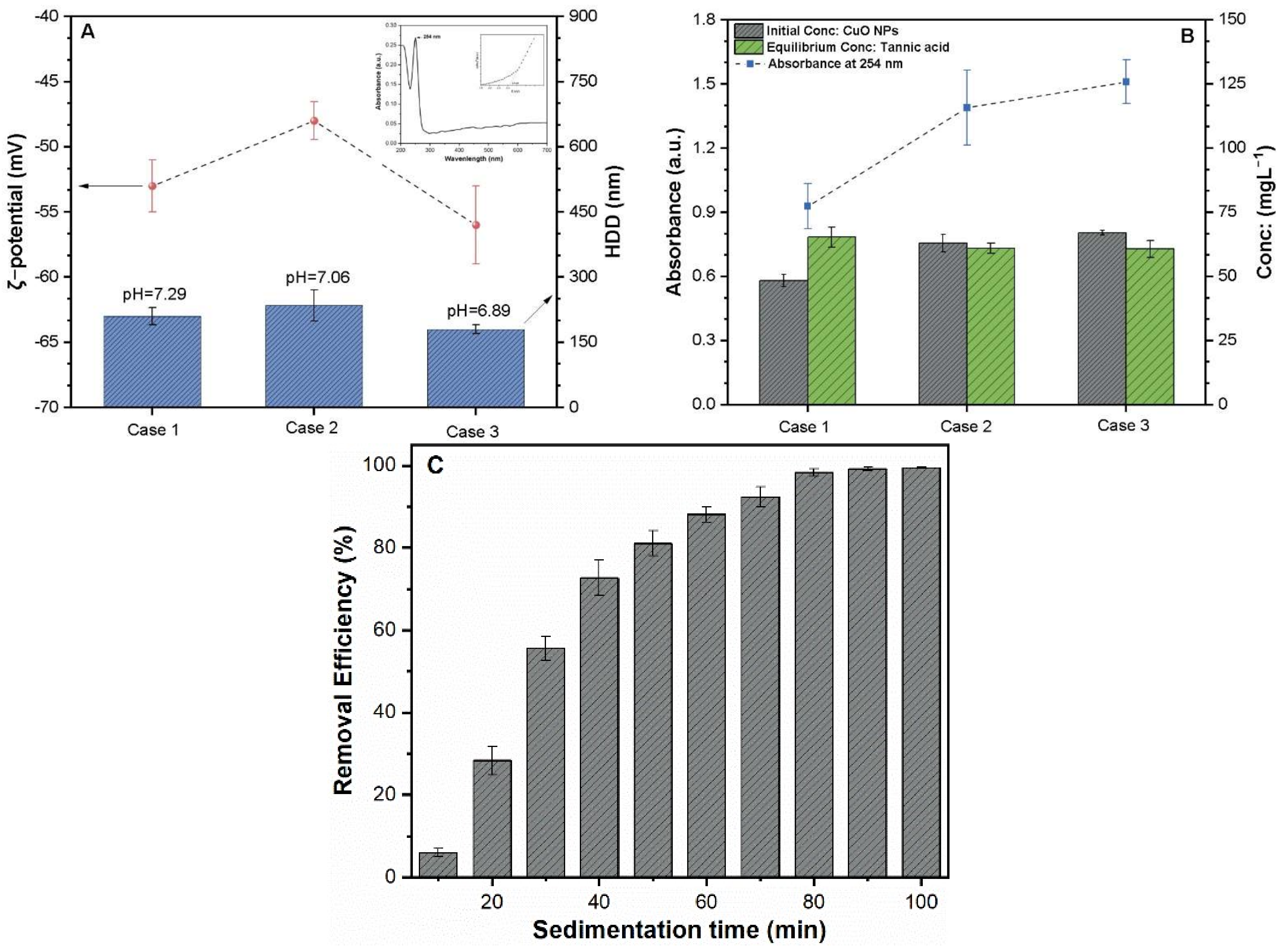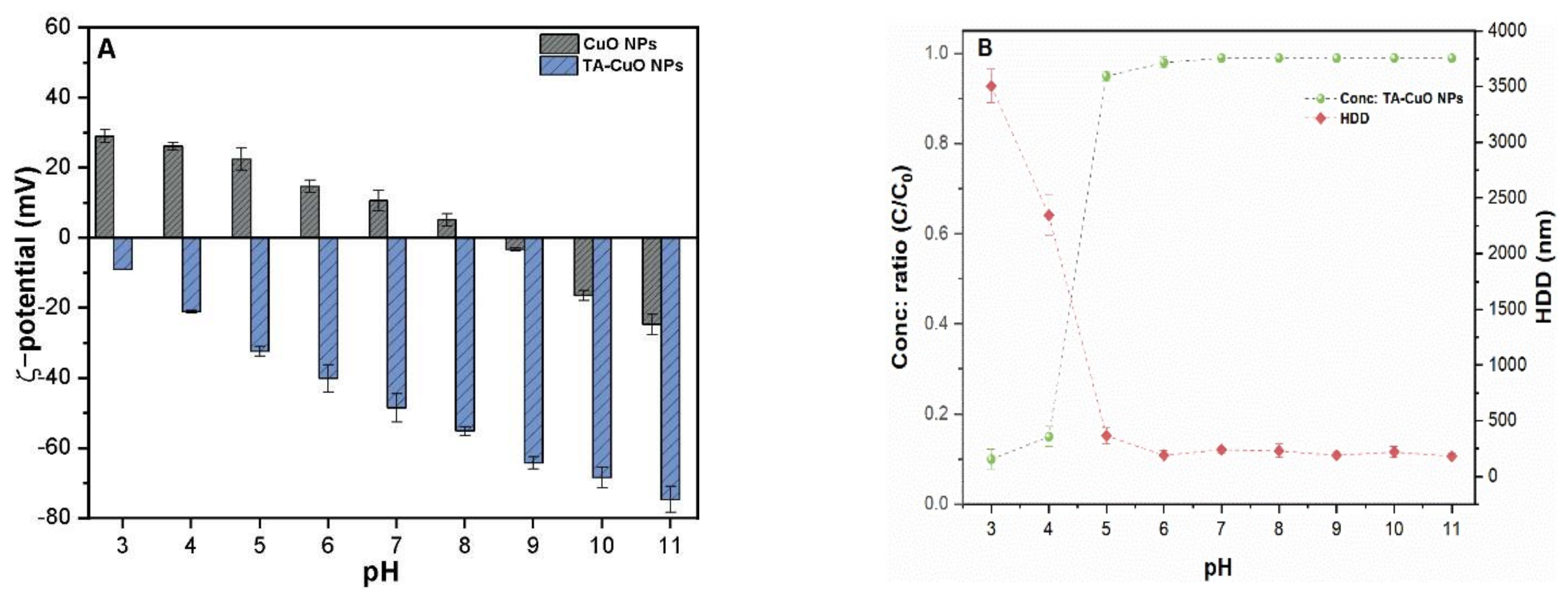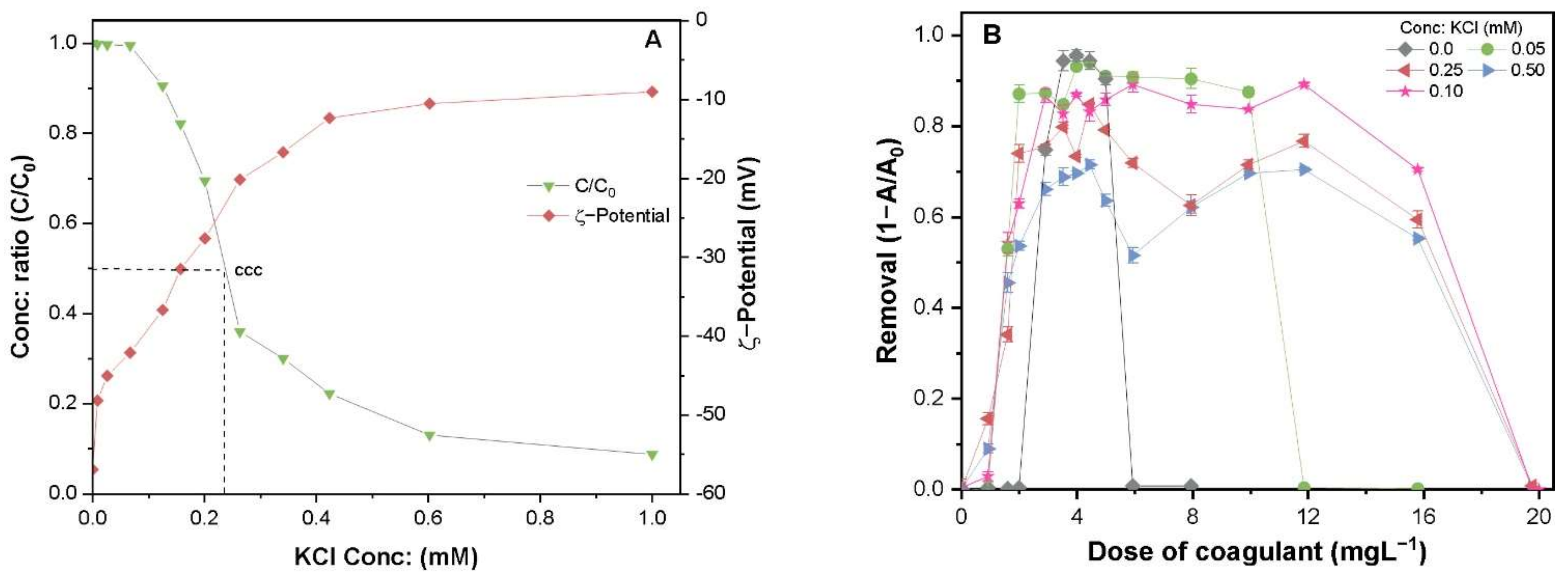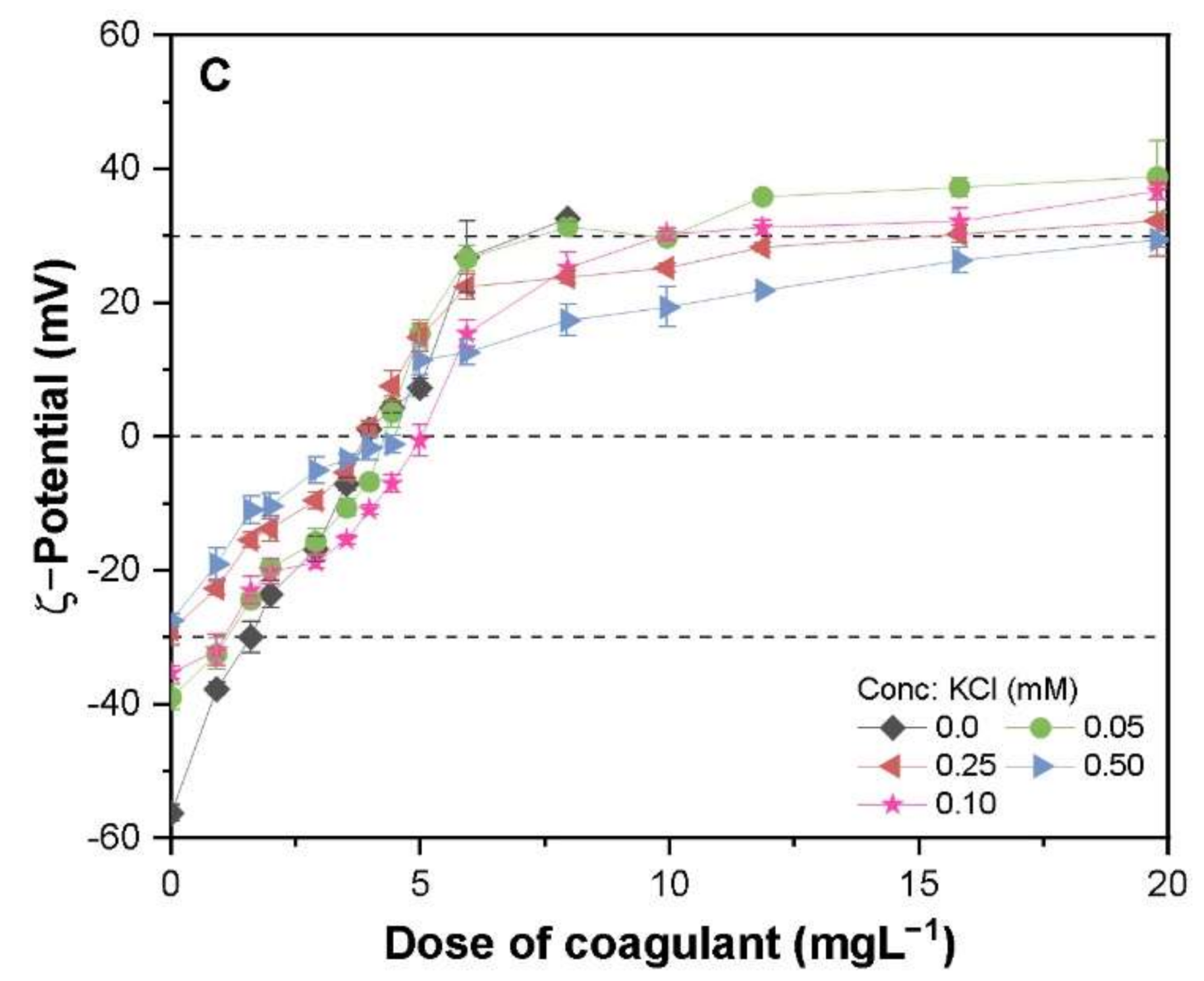Removal of Tannic Acid Stabilizes CuO Nanoparticles from Aqueous Media by PAFC: Effect of Process Conditions and Water Chemistry
Abstract
:1. Introduction
2. Results and Discussion
2.1. Characteristics of the Stabilized TA-CuO NP Suspension
2.2. Effect of Hydraulic Settings on the Removal Efficiency of TA-CuO NPs
2.3. Influence of Solution pH on the Stability of TA-CuO NPs
2.4. Influence of Solution pH on the Removal of TA-CuO NP Suspension
2.5. Influence of Electrolyte Concentration on the Stability and Removal of TA-CuO NPs
2.6. Effect of TA-Stabilized CuO NP Concentration on the Removal Process
3. Materials and Methods
3.1. Materials
3.2. Stock Solution
3.3. Coagulation Experiments
3.4. Experimental Matrices
3.5. Analytical Procedure
4. Conclusions
Author Contributions
Funding
Data Availability Statement
Acknowledgments
Conflicts of Interest
Sample Availability
References
- Sun, T.Y.; Bornhöft, N.A.; Hungerbühler, K.; Nowack, B. Dynamic probabilistic modeling of environmental emissions of engineered nanomaterials. Environ. Sci. Technol. 2016, 50, 4701–4711. [Google Scholar] [CrossRef] [PubMed]
- Pietroiusti, A.; Stockmann-Juvala, H.; Lucaroni, F.; Savolainen, K. Nanomaterial exposure, toxicity, and impact on human health. WIREs Nanomed. Nanobiotechnol. 2018, 10, e1513. [Google Scholar] [CrossRef]
- Zhao, J.; Lin, M.; Wang, Z.; Cao, X.; Xing, B. Engineered nanomaterials in the environment: Are they safe? Crit. Rev. Environ. Sci. Technol. 2021, 51, 1443–1478. [Google Scholar] [CrossRef]
- Peng, C.; Shen, C.; Zheng, S.; Yang, W.; Hu, H.; Liu, J.; Shi, J. Transformation of CuO Nanoparticles in the Aquatic Environment: Influence of pH, Electrolytes and Natural Organic Matter. Nanomaterials 2017, 7, 326. [Google Scholar] [CrossRef] [Green Version]
- Xiao, Y.; Vijver, M.G.; Peijnenburg, W.J.G.M. Impact of water chemistry on the behavior and fate of copper nanoparticles. Environ. Pollut. 2018, 234, 684–691. [Google Scholar] [CrossRef] [PubMed] [Green Version]
- Bondarenko, O.; Juganson, K.; Ivask, A.; Kasemets, K.; Mortimer, M.; Kahru, A. Toxicity of Ag, CuO and ZnO nanoparticles to selected environmentally relevant test organisms and mammalian cells in vitro: A critical review. Arch. Toxicol. 2013, 87, 1181–1200. [Google Scholar] [CrossRef] [Green Version]
- Kiser, M.A.; Ryu, H.; Jang, H.; Hristovski, K.; Westerhoff, P. Biosorption of nanoparticles to heterotrophic wastewater biomass. Water Res. 2010, 44, 4105–4114. [Google Scholar] [CrossRef]
- Westerhoff, P.K.; Kiser, A.; Hristovski, K. Nanomaterial removal and transformation during biological wastewater treatment. Environ. Mar. 2013, 30, 109–117. [Google Scholar] [CrossRef]
- Springer, F.; Laborie, S.; Guigui, C. Removal of SiO2 nanoparticles from industry wastewaters and subsurface waters by ultrafiltration: Investigation of process efficiency, deposit properties and fouling mechanism. Sep. Purif. Technol. 2013, 108, 6–14. [Google Scholar] [CrossRef]
- Abbott Chalew, T.E.; Ajmani, G.S.; Huang, H.; Schwab, K.J. Evaluating nanoparticle breakthrough during drinking water treatment. Environ. Health Perspect. 2013, 121, 1161–1166. [Google Scholar] [CrossRef] [PubMed]
- Chang, M.R.; Lee, D.J.; Lai, J.Y. Nanoparticles in wastewater from a science-based industrial park-Coagulation using polyaluminum chloride. J. Environ. Manag. 2007, 85, 1009–1014. [Google Scholar] [CrossRef] [PubMed]
- Zhang, Y.; Chen, Y.; Westerhoff, P.; Crittenden, J.C. Stability and removal of water soluble CdTe quantum dots in water. Environ. Sci. Technol. 2007, 42, 321–325. [Google Scholar] [CrossRef]
- Petosa, A.R.; Jaisi, D.P.; Quevedo, I.R.; Elimelech, M.; Tufenkji, N. Aggregation and deposition of engineered nanomaterials in aquatic environments: Role of physicochemical interactions. Environ. Sci. Technol. 2010, 44, 6532–6549. [Google Scholar] [CrossRef] [Green Version]
- Boncel, S.; Kyziol-Komosińska, J.; Krzyzewska, I.; Czupiol, J. Interactions of carbon nanotubes with aqueous/aquatic media containing organic/inorganic contaminants and selected organisms of aquatic ecosystems—A review. Chemosphere 2015, 136, 211–221. [Google Scholar] [CrossRef]
- Liu, N.; Liu, C.; Zhang, J.; Lin, D. Removal of dispersant-stabilized carbon nanotubes by regular coagulants. J. Environ. Sci. 2012, 24, 1364–1370. [Google Scholar] [CrossRef]
- Bian, S.W.; Mudunkotuwa, I.A.; Rupasinghe, T.; Grassian, V.H. Aggregation and dissolution of 4 nm ZnO nanoparticles in aqueous environments: Influence of pH, ionic strength, size, and adsorption of humic acid. Langmuir 2011, 27, 6059–6068. [Google Scholar] [CrossRef]
- Merzouk, B.; Gourich, B.; Madani, K.; Vial, C.; Sekki, A. Removal of a disperse red dye from synthetic wastewater by chemical coagulation and continuous electrocoagulation. A comparative study. Desalination 2011, 272, 246–253. [Google Scholar] [CrossRef]
- Wang, Y.; Xue, N.; Chu, Y.; Sun, Y.; Yan, H.; Han, Q. CuO nanoparticle-humic acid (CuONP-HA) composite contaminant removal by coagulation/ultrafiltration process: The application of sodium alginate as coagulant aid. Desalination 2015, 367, 265–271. [Google Scholar] [CrossRef]
- Lin, D.; Liu, N.; Yang, K.; Xing, B.; Wu, F. Different stabilities of multiwalled carbon nanotubes in fresh surface water samples. Environ. Pollut. 2010, 158, 1270–1274. [Google Scholar] [CrossRef]
- Surawanvijit, S.; Liu, H.H.; Kim, M.; Cohen, Y. Removal of Metal Oxide Nanoparticles from Aqueous Suspensions. Sep. Sci. Technol. 2014, 49, 161–170. [Google Scholar] [CrossRef]
- Tang, H.; Xiao, F.; Wang, D. Speciation, stability, and coagulation mechanisms of hydroxyl aluminum clusters formed by PACl and alum: A critical review. Adv. Colloid Interface Sci. 2015, 226, 78–85. [Google Scholar] [CrossRef] [PubMed]
- Wang, Y.; Gao, B.Y.; Xu, X.M.; Xu, W.Y. The effect of total hardness and ionic strength on the coagulation performance and kinetics of aluminum salts to remove humic acid. Chem. Eng. J. 2010, 160, 150–156. [Google Scholar] [CrossRef]
- Pǎcalǎ, A.; Vlaicu, I.; Radovan, C. Comparative studies on the efficiency of aluminium coagulants. Environ. Eng. Manag. J. 2012, 11, 427–434. [Google Scholar] [CrossRef]
- Rajar, K.; Soomro, R.A.; Ibupoto, Z.H.; Balouch, S.; Balouch, A. Tannic acid assisted copper oxide nanoglobules for sensitive electrochemical detection of bisphenol A. Int. J. Food Prop. 2017, 20, 1359–1367. [Google Scholar] [CrossRef]
- Zhao, J.; Liu, Y.; Pan, B.; Gao, G.; Liu, Y.; Liu, S.; Liang, N.; Zhou, D.; Vijver, M.G.; Peijnenburg, W.J.G.M. Tannic acid promotes ion release of copper oxide nanoparticles: Impacts from solution pH change and complexation reactions. Water Res. 2017, 127, 59–67. [Google Scholar] [CrossRef]
- Zhang, Y.; Li, S.; Wang, X.; Ma, X.; Wang, W.; Li, X. Synthesis, purification and characterization of polyaluminum ferric chloride (PAFC) with high (Al + Fe)b content. Sep. Purif. Technol. 2015, 146, 311–316. [Google Scholar] [CrossRef]







Publisher’s Note: MDPI stays neutral with regard to jurisdictional claims in published maps and institutional affiliations. |
© 2021 by the authors. Licensee MDPI, Basel, Switzerland. This article is an open access article distributed under the terms and conditions of the Creative Commons Attribution (CC BY) license (https://creativecommons.org/licenses/by/4.0/).
Share and Cite
Khan, R.; Inam, M.A.; Lee, K.H. Removal of Tannic Acid Stabilizes CuO Nanoparticles from Aqueous Media by PAFC: Effect of Process Conditions and Water Chemistry. Molecules 2021, 26, 5615. https://doi.org/10.3390/molecules26185615
Khan R, Inam MA, Lee KH. Removal of Tannic Acid Stabilizes CuO Nanoparticles from Aqueous Media by PAFC: Effect of Process Conditions and Water Chemistry. Molecules. 2021; 26(18):5615. https://doi.org/10.3390/molecules26185615
Chicago/Turabian StyleKhan, Rizwan, Muhammad Ali Inam, and Kang Hoon Lee. 2021. "Removal of Tannic Acid Stabilizes CuO Nanoparticles from Aqueous Media by PAFC: Effect of Process Conditions and Water Chemistry" Molecules 26, no. 18: 5615. https://doi.org/10.3390/molecules26185615
APA StyleKhan, R., Inam, M. A., & Lee, K. H. (2021). Removal of Tannic Acid Stabilizes CuO Nanoparticles from Aqueous Media by PAFC: Effect of Process Conditions and Water Chemistry. Molecules, 26(18), 5615. https://doi.org/10.3390/molecules26185615







